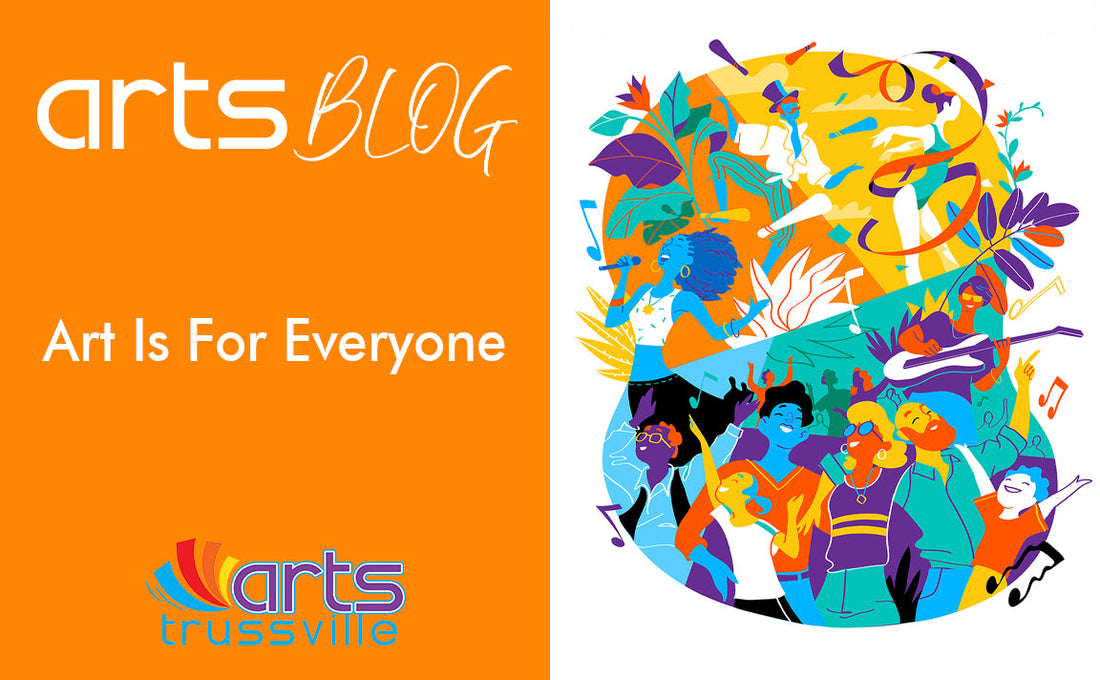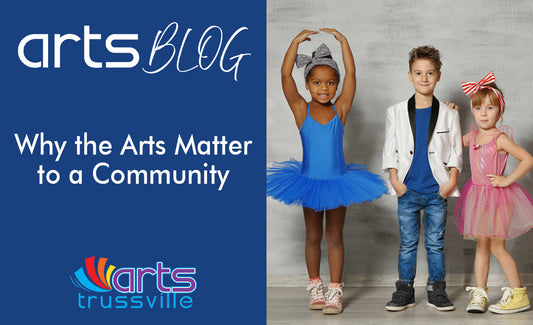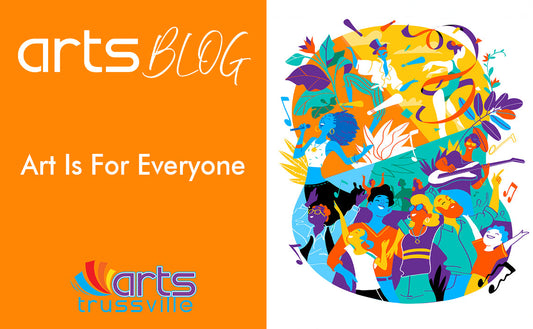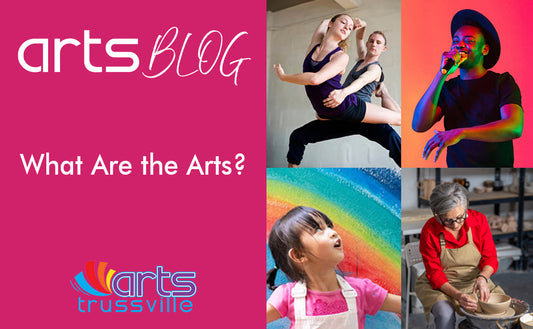 Art Is for Everyone
Art Is for Everyone
What comes to mind when you think of “art”?
Maybe it’s a painting hanging in a museum, a classical music concert, or a sculpture you’re not quite sure how to interpret. And yes—those are all part of the arts. But they’re not the whole picture. Not even close.

At Arts Trussville, we believe something powerful:
Art is not just for galleries. Art is not just for “artists.”
Art is for everyone.
You don’t need a degree, a studio, or a big audience to be creative. If you’ve ever doodled in the margin of a notebook, baked a birthday cake with flair, or hummed a tune on your walk—congrats, you’ve made art.
🖌 Breaking Down the Myth
For too long, the arts have carried a reputation of being elitist—exclusive, expensive, or intimidating. But the truth is, art belongs to all of us. Creativity is part of what makes us human. It lives in every culture, every age group, every community.

Art isn’t about perfection. It’s about expression.
You don’t have to understand every painting to enjoy them. You don’t have to be on stage to love music. And you don’t need to sell your work to be a real artist.
 A History of Human Creativity
A History of Human Creativity
Art has been with us from the very beginning. Long before written language or formal education, people were creating—painting, carving, singing, dancing, and telling stories.
Cave paintings in Lascaux, France, estimated to be over 17,000 years old, depict animals and scenes from daily life. In southern Africa, engraved stones and ochre markings date back nearly 75,000 years. These early works weren’t just decoration—they were communication, storytelling, and ritual.

Photograph of cave paintings in the Lascaux prehistoric caves, Montignac, France. Photo courtesy of Wikipedia.
Across cultures and time, people used many forms of art to connect with each other and with something greater than themselves.


Mask from Gabon. Photograph courtesy of Wikipedia.

📖 Literature & Storytelling
Long before books and printing presses, humans were telling stories—out loud, around fires, beneath stars, in song and in verse. Oral storytelling was how cultures preserved their histories, passed on wisdom, and shared who they were. It was a living art form, passed from voice to voice, generation to generation.
Through myths, legends, epic poems, and folktales, communities passed down family lineages, survival knowledge, moral lessons, and spiritual beliefs. The Greeks gave us tales of gods and heroes through epic poems like The Iliad and The Odyssey. The Yoruba of West Africa kept history alive through the spoken word and the rhythmic call-and-response of griots—oral historians and praise poets. Polynesian navigators told stories that were part memory, part map—guiding them across oceans. Many Native American tribes used storytelling not only to teach but to heal, honor, and ground people in the rhythms of the Earth.
One of the earliest surviving written stories in human history is The Epic of Gilgamesh, carved into clay tablets over 4,000 years ago in ancient Mesopotamia (modern-day Iraq). This powerful tale of friendship, kingship, and the search for meaning began as oral legend before being recorded in cuneiform—the earliest known writing system. It shows us that even in humanity’s earliest cities, people were already wrestling with life’s big questions through the power of story.
These stories weren’t just entertainment—they were education, history, culture, and connection, woven into ceremonies, dances, and community life.
And even today, you can hear echoes of these traditions in poetry slams, bedtime stories, theater, sermons, podcasts, and even TikTok videos. The tools may have changed—but the human need to tell and hear stories remains.

A traditional Kyrgyz manaschi performing part of the
Epic of Manas at a yurt camp in Karakol.
Photograph courtesy of Wikipedia.

🎶 Music
Music is one of the oldest and most universal forms of human expression. Archaeologists have uncovered flutes made from bird bones and mammoth ivory in Europe and Asia that are over 40,000 years old—meaning people were making music long before written language, agriculture, or the wheel.
From the very beginning, music has been deeply tied to human life. It’s been used to celebrate, to mourn, to worship, to work, and to soothe. Across cultures and centuries, music has played a role in ceremonies, healing rituals, storytelling, and entertainment. Whether it was a steady rhythm to help coordinate a group rowing a boat, a celebratory drum circle after a harvest, or a lullaby sung by a parent to a child—music was always present.
Early instruments began simply—hand drums, rattles, and hollow reeds—and gradually evolved into more complex creations like lyres, harps, and stringed instruments. And of course, the voice has always been a powerful instrument on its own.
What’s most striking is that no matter the culture or time period, people found ways to create music. It didn’t require wealth or training—just a desire to express and connect. That’s as true today as it was 40,000 years ago.

Native American Shaman playing ritual drum.
💡 Did You Know?
🎶 One of the oldest known musical instruments—a bone flute—was made over 40,000 years ago and discovered in a cave in Germany. That means humans were playing music before we built cities.


Dance – From tribal ceremonies to folk dances and early theater, movement has always been a way to express joy, sorrow, worship, and identity. In many cultures, dance was a community act—accessible to all, not just a performance for a few.
20 Dance Styles from Around the World. Video courtesy of BusinessInsider.com.
Throughout history, art in all its forms wasn’t reserved for royalty or elites. It was part of everyday life. Everyone sang. Everyone danced. Everyone told stories. That shared creative expression helped people heal, celebrate, teach, and imagine—and it still does.
🌎 Creativity Happens Everywhere

Here in Trussville, we see art happening in places you might not expect:
-
Sidewalk chalk drawings outside schools
-
Teens painting skateboards or decorating their shoes
-
Church theater productions and holiday craft fairs
-
Parents making centerpieces for a banquet
-
Seniors quilting memory blankets or journaling their life stories
- Artists creating murals on buildings, showcasing their collaborative efforts in public spaces
That’s all art. It’s meaningful. And it matters.
🛠 You Don’t Need Fancy Supplies
Creativity doesn’t have to be expensive. Some of the best art starts with what you already have:
-
Scrap paper and markers? Make a zine or comic.
-
Old T-shirts? Try tie-dye or no-sew fashion hacks.
-
Found objects? Create a sculpture or collage.
-
A phone? Record a video poem or start a sketch series on Instagram.

And if you want to learn or try something new—local resources like Arts Trussville events, the Trussville Library, and even Alabama Art Supply are here to help.
❤️ Art Builds Confidence, Connection, and Joy
When people have access to the arts, something magical happens:
-
Kids become more confident.
-
Adults reconnect with themselves.
-
Neighbors get to know each other.
-
Families make memories.

Art creates a space where everyone belongs.
You don’t need permission to create. You just need a moment—and maybe a little encouragement.
🗣️ The Artist in All of Us
 “Every child is an artist. The problem is how to remain an artist once we grow up.”
“Every child is an artist. The problem is how to remain an artist once we grow up.”— Pablo Picasso
You Are Welcome Here
Whether you’re a painter, a poet, a hobbyist crafter, or someone who hasn’t made art since elementary school—you are part of the arts community.

We invite you to explore, to try, to play. Join us at an event, come to a show, take a class, or just start creating at your kitchen table. There’s no right way to be an artist. There’s just your way.
Because in Trussville—and everywhere else—art is for everyone.





